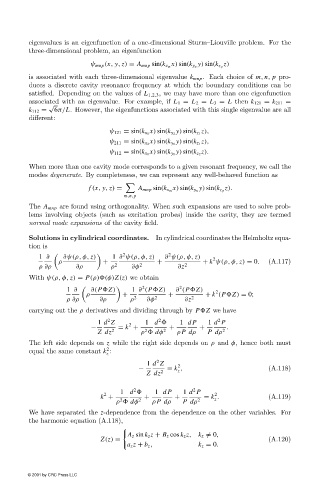Page 502 - Electromagnetics
P. 502
eigenvalues is an eigenfunction of a one-dimensional Sturm–Liouville problem. For the
three-dimensional problem, an eigenfunction
z)
ψ mnp (x, y, z) = A mnp sin(k x m x) sin(k y n y) sin(k z p
is associated with each three-dimensional eigenvalue k mnp . Each choice of m, n, p pro-
duces a discrete cavity resonance frequency at which the boundary conditions can be
satisfied. Depending on the values of L 1,2,3 , we may have more than one eigenfunction
associated with an eigenvalue. For example, if L 1 = L 2 = L 3 = L then k 121 = k 211 =
√
k 112 = 6π/L. However, the eigenfunctions associated with this single eigenvalue are all
different:
z),
ψ 121 = sin(k x 1 x) sin(k y 2 y) sin(k z 1
z),
ψ 211 = sin(k x 2 x) sin(k y 1 y) sin(k z 1
z).
ψ 112 = sin(k x 1 x) sin(k y 1 y) sin(k z 2
When more than one cavity mode corresponds to a given resonant frequency, we call the
modes degenerate. By completeness, we can represent any well-behaved function as
f (x, y, z) = A mnp sin(k x m x) sin(k y n y) sin(k z p z).
m,n,p
The A mnp are found using orthogonality. When such expansions are used to solve prob-
lems involving objects (such as excitation probes) inside the cavity, they are termed
normal mode expansions of the cavity field.
Solutions in cylindrical coordinates. In cylindrical coordinates the Helmholtz equa-
tion is
2
2
1 ∂ ∂ψ(ρ, φ, z) 1 ∂ ψ(ρ, φ, z) ∂ ψ(ρ, φ, z) 2
ρ + + + k ψ(ρ, φ, z) = 0. (A.117)
ρ ∂ρ ∂ρ ρ 2 ∂φ 2 ∂z 2
With ψ(ρ, φ, z) = P(ρ)#(φ)Z(z) we obtain
2
2
1 ∂ ∂(P#Z) 1 ∂ (P#Z) ∂ (P#Z) 2
ρ + + + k (P#Z) = 0;
ρ ∂ρ ∂ρ ρ 2 ∂φ 2 ∂z 2
carrying out the ρ derivatives and dividing through by P#Z we have
2
2
2
1 d Z 2 1 d # 1 dP 1 d P
− = k + + + .
Z dz 2 ρ # dφ 2 ρP dρ P dρ 2
2
The left side depends on z while the right side depends on ρ and φ, hence both must
2
equal the same constant k :
z
2
1 d Z 2
− 2 = k , (A.118)
z
Z dz
2
2
1 d # 1 dP 1 d P
2 2
k + + + = k . (A.119)
z
2
ρ # dφ 2 ρP dρ P dρ 2
We have separated the z-dependence from the dependence on the other variables. For
the harmonic equation (A.118),
A z sin k z z + B z cos k z z, k z = 0,
Z(z) = (A.120)
a z z + b z , k z = 0.
© 2001 by CRC Press LLC

